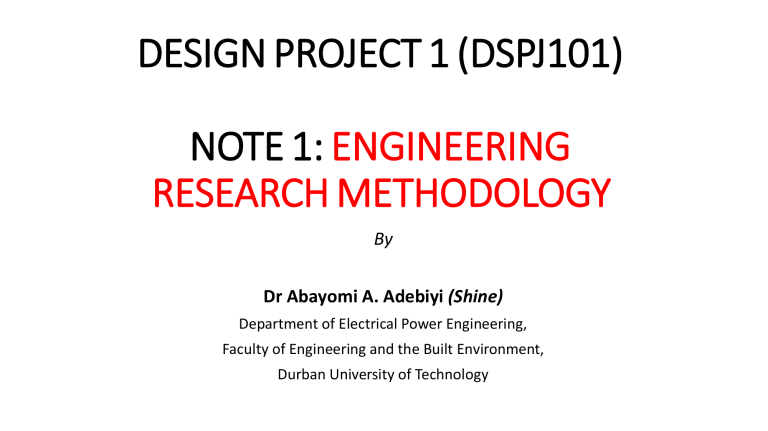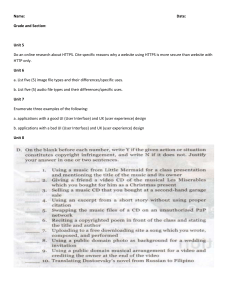
DESIGN PROJECT 1 (DSPJ101) NOTE 1: ENGINEERING RESEARCH METHODOLOGY By Dr Abayomi A. Adebiyi (Shine) Department of Electrical Power Engineering, Faculty of Engineering and the Built Environment, Durban University of Technology OUTLINE • • • • • • • • • • • WHAT IS RESEARCH? RESEARCH METHODOLOGY ENGINEERING DESIGN PROCESS VS THE SCIENTIFIC METHOD DIFFERENT TYPES OF RESEARCH ACTIVITIES FINDING A RESEARCH TOPIC PROJECT SCOPE, AIM & OBJECTIVE LITERATURE REVIEW ACADEMIC SEARCH EVALUATION & COMPARISON RESEARCH REPORT OUTLINE/CONTENT WHAT IS RESEARCH ? • The systematic investigation into and study of materials, sources, etc., in order to establish facts and reach new conclusions. • An endeavour to discover new or collate old facts etc. by the scientific study of a subject or by a course of critical investigation • Research is a systematic, scientific, controlled, and empirical process. • Systematic---step by step • Scientific---logical steps to follow • Controlled---covers a limited area (scope) • • • • Time Geographical coverage/area Respondents Contents(various) • Empirical---evidence based data SCIENTIFIC INVESTIGATION • A scientistic investigation usually starts with an observation—that is, something that catches the scientist’s attention. • The scientific method is a logical problem-solving approach used by scientists and other researchers. 1. Make an observation. 2. Ask a question. 3. Form a hypothesis, or testable explanation. 4. Make a prediction based on the hypothesis. 5. Test the prediction. 6. Iterate: use the results to make new hypotheses or predictions. Scientific method example: Failure to toast RESEARCH METHODOLOGIES • Scientific method • Engineering method • Empirical method • Analytical method SCIENTIFIC METHOD 5. If possible, repeat 1. Observe realworld 2. Propose a model or theory of some realworld phenomena 4. Validate hypotheses of the model or theory 3. Measure and analyze above ENGINEERING METHOD 5. Repeat until no further improvements are possible 1. Observe existing solutions 4. Measure, analyze, and evaluate 2. Propose better solutions 3. Build or develop better solution EMPIRICAL METHOD 5. Validate and then repeat 1. Propose a model 2. Develop statistical or other bases for the model 4. Measure and analyze 3. Apply to case studies ANALYTICAL METHOD 1. Propose a formal theory or set of axioms 5. Refine theory if necessary 4. If possible, compare with empirical observations 2. Develop a theory 3. Derive results ENGINEERING DESIGN PROCESS VS THE SCIENTIFIC METHOD ENGINEERING DESIGN PROCESS VS THE SCIENTIFIC METHOD DIFFERENT TYPES OF RESEARCH • Fundamental or Basic Research; The undertaking of research with the aim of advancing the current state of knowledge and to develop an understanding of a fundamental or basic process, phenomenon, material, or event. • Applied Research; Original work undertaken to acquire new knowledge with a specific practical application in view. Applied research is undertaken to determine possible uses for the findings of basic research or to determine new methods or ways of achieving some specific and predetermined objective. • Developmental Research; Development is a process of arriving at a satisfactory design of a viable application of new knowledge by employing sequential cycles of designing, testing, and evaluating. ACTIVITIES • Find your Topic • Do a review of the literature • Formulate your thesis • Defend your thesis title • Develop your solution • Validate and compare your answer • Write up • Defend your thesis FINDING A RESEARCH TOPIC Defining a Topic • Usefulness and interest- Will the results be useful? Will they make the world a better place • Feasibility- Are you likely to be able to get the data, etc to research the topic properly? The project should be reasonably challenging, but not impossible What to do • Identify what you know about your topic and the questions you still have • Start with general background information: e.g. Google search, newspaper and magazine articles. • Look for more specialized information: e.g. Scholarly articles and books via library databases. What are the qualities of a good research topic ✓ Clear: Clarity is the most important quality of any research topic ✓ Well-defined: Well-defined and well-phrased research topic is a half guarantee of a successful research. ✓ Current importance: Current importance should also be the consideration of the researcher while selecting a research topic. PROJECT SCOPE, AIM & OBJECTIVE • You need to make the scope of the project clear and clarify the meaning of any key terms used. • It is a goodidea to summarize the main aim of your research in a single phrase or sentence • The project aims should: • • • • be as simple and clear as possible; be coherent (fit together), refer to practical and/or theoretical outcomes; be listed near the start of the project report DIFFERENCE BETWEEN AIM AND OBJECTIVE • The aim is the what of the project, and the objective is the how. • The aim is about what you hope to do, your overall intention in the project. It signals what and/or where you aspire to be by the end. “The aim in this project is … to develop, to design, to generate, to build” • The objectives are usually more than one, are the specific steps you will take to achieve your aim. This is where you make the project tangible by saying how you are going to go about it. • Objectives have to be practical, do-able and achievable. • the objectives also act as project milestones, it’s helpful to express them as things that are able to be completed. LITERATURE REVIEW As you write your review, consider these ways of expressing your ideas: • Compare and contrast views of different authors. • Criticize previous work. • Highlight gaps in existing research. • Show how your work relates to previous work. • Identify problems, conflicts, debates, gaps. • Define a research area in a new way. • Question previous results. SEARCH LIBRARY • Connect to the University Library on https://library.dut.ac.za/ ACADEMIC SEARCH • academic databases • Web of Science (https://access.clarivate.com/login) • Scopus (https://www.scopus.com/home.uri) • academic search engines • • • • • • • • Google Scholar (https://scholar.google.com/) Microsoft Academic (https://www.microsoft.com/en-za/) BASE (https://www.base-search.net/) CORE (https://core.ac.uk/) Science.gov (https://www.science.gov/) Semantic Scholar (https://www.semanticscholar.org/) Baidu Scholar (https://xueshu.baidu.com/) RefSeek EVALUATION & COMPARISON • Validate your results • Simulation methods & tools • Analyze your results • Use Scientific approaches • Compare with similar works • Redo their work • Compare with the published results • Use standard metrics (if exists) • Concentrate on both pros & cons RESEARCH REPORT OUTLINE/CONTENT • PREFATORY • CHAPTER 1: Introduction • CHAPTER 2: Literature Review • CHAPTER 3: Design Methodology • CHAPTER 4: Result and Discussion • CHAPTER 5: Conclusions and Recommendations • References • Appendix END THANKS






